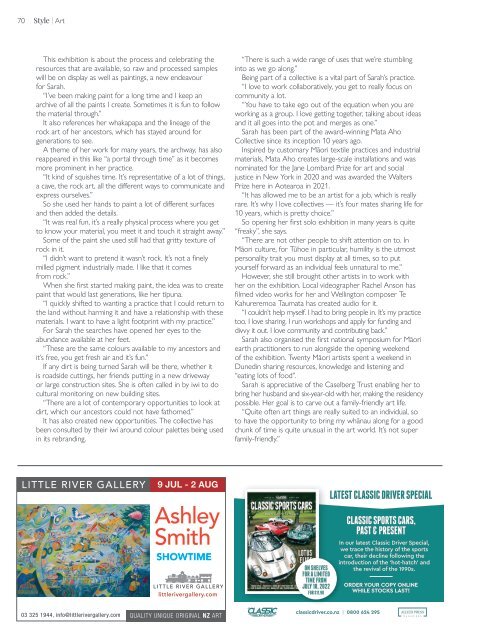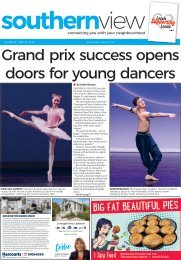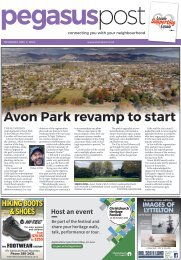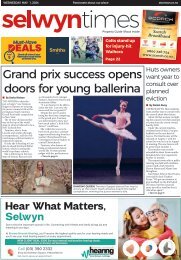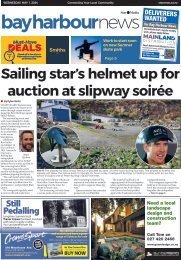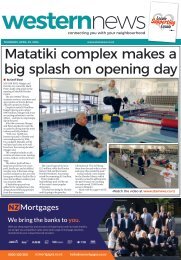Style: July 01, 2022
Create successful ePaper yourself
Turn your PDF publications into a flip-book with our unique Google optimized e-Paper software.
70 <strong>Style</strong> | Art<br />
This exhibition is about the process and celebrating the<br />
resources that are available, so raw and processed samples<br />
will be on display as well as paintings, a new endeavour<br />
for Sarah.<br />
“I’ve been making paint for a long time and I keep an<br />
archive of all the paints I create. Sometimes it is fun to follow<br />
the material through.”<br />
It also references her whakapapa and the lineage of the<br />
rock art of her ancestors, which has stayed around for<br />
generations to see.<br />
A theme of her work for many years, the archway, has also<br />
reappeared in this like “a portal through time” as it becomes<br />
more prominent in her practice.<br />
“It kind of squishes time. It’s representative of a lot of things,<br />
a cave, the rock art, all the different ways to communicate and<br />
express ourselves.”<br />
So she used her hands to paint a lot of different surfaces<br />
and then added the details.<br />
“It was real fun, it’s a really physical process where you get<br />
to know your material, you meet it and touch it straight away.”<br />
Some of the paint she used still had that gritty texture of<br />
rock in it.<br />
“I didn’t want to pretend it wasn’t rock. It’s not a finely<br />
milled pigment industrially made. I like that it comes<br />
from rock.”<br />
When she first started making paint, the idea was to create<br />
paint that would last generations, like her tīpuna.<br />
“I quickly shifted to wanting a practice that I could return to<br />
the land without harming it and have a relationship with these<br />
materials. I want to have a light footprint with my practice.”<br />
For Sarah the searches have opened her eyes to the<br />
abundance available at her feet.<br />
“These are the same colours available to my ancestors and<br />
it’s free, you get fresh air and it’s fun.”<br />
If any dirt is being turned Sarah will be there, whether it<br />
is roadside cuttings, her friends putting in a new driveway<br />
or large construction sites. She is often called in by iwi to do<br />
cultural monitoring on new building sites.<br />
“There are a lot of contemporary opportunities to look at<br />
dirt, which our ancestors could not have fathomed.”<br />
It has also created new opportunities. The collective has<br />
been consulted by their iwi around colour palettes being used<br />
in its rebranding.<br />
“There is such a wide range of uses that we’re stumbling<br />
into as we go along.”<br />
Being part of a collective is a vital part of Sarah’s practice.<br />
“I love to work collaboratively, you get to really focus on<br />
community a lot.<br />
“You have to take ego out of the equation when you are<br />
working as a group. I love getting together, talking about ideas<br />
and it all goes into the pot and merges as one.”<br />
Sarah has been part of the award-winning Mata Aho<br />
Collective since its inception 10 years ago.<br />
Inspired by customary Māori textile practices and industrial<br />
materials, Mata Aho creates large-scale installations and was<br />
nominated for the Jane Lombard Prize for art and social<br />
justice in New York in 2020 and was awarded the Walters<br />
Prize here in Aotearoa in 2021.<br />
“It has allowed me to be an artist for a job, which is really<br />
rare. It’s why I love collectives — it’s four mates sharing life for<br />
10 years, which is pretty choice.”<br />
So opening her first solo exhibition in many years is quite<br />
“freaky”, she says.<br />
“There are not other people to shift attention on to. In<br />
Māori culture, for Tūhoe in particular, humility is the utmost<br />
personality trait you must display at all times, so to put<br />
yourself forward as an individual feels unnatural to me.”<br />
However, she still brought other artists in to work with<br />
her on the exhibition. Local videographer Rachel Anson has<br />
filmed video works for her and Wellington composer Te<br />
Kahureremoa Taumata has created audio for it.<br />
“I couldn’t help myself. I had to bring people in. It’s my practice<br />
too. I love sharing. I run workshops and apply for funding and<br />
divvy it out. I love community and contributing back.”<br />
Sarah also organised the first national symposium for Māori<br />
earth practitioners to run alongside the opening weekend<br />
of the exhibition. Twenty Māori artists spent a weekend in<br />
Dunedin sharing resources, knowledge and listening and<br />
“eating lots of food”.<br />
Sarah is appreciative of the Caselberg Trust enabling her to<br />
bring her husband and six-year-old with her, making the residency<br />
possible. Her goal is to carve out a family-friendly art life.<br />
“Quite often art things are really suited to an individual, so<br />
to have the opportunity to bring my whānau along for a good<br />
chunk of time is quite unusual in the art world. It’s not super<br />
family-friendly.”<br />
LITTLE RIVER GALLERY<br />
9 JUL - 2 AUG<br />
Ashley<br />
Smith<br />
SHOWTIME<br />
littlerivergallery.com<br />
On ShELVES<br />
fOR A LImITED<br />
TImE fROm<br />
JuLy 18, <strong>2022</strong><br />
fOR $11.90<br />
LATEST CLASSIC DRIVER SPECIAL<br />
CLASSIC SPORTS CARS,<br />
PAST & PRESEnT<br />
In our latest Classic Driver Special,<br />
we trace the history of the sports<br />
car, their decline following the<br />
introduction of the ‘hot-hatch’ and<br />
the revival of the 1990s.<br />
Order yOur cOpy Online<br />
while stOcks last!<br />
03 325 1944, info@littlerivergallery.com<br />
QUALITY UNIQUE ORIGINAL NZ ART<br />
classicdriver.co.nz | 0800 624 295


